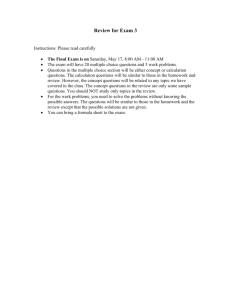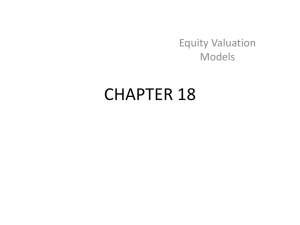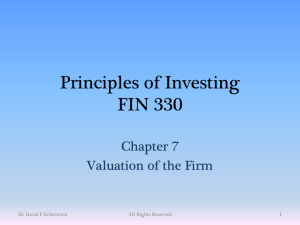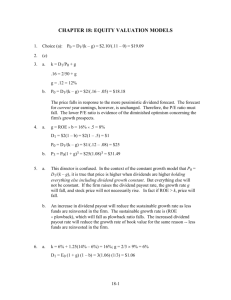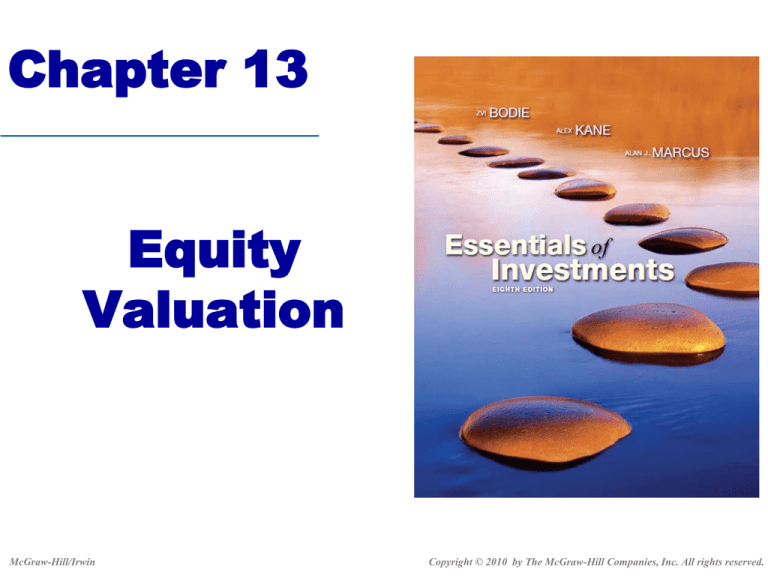
Chapter 13
Equity
Valuation
McGraw-Hill/Irwin
Copyright © 2010 by The McGraw-Hill Companies, Inc. All rights reserved.
Fundamental Stock Analysis:
Models of Equity Valuation
• Basic Types of Models
– Balance Sheet Models
– Dividend Discount Models
– Price/Earnings Ratios
– Free Cash Flow Models
13-2
Models of Equity Valuation
• Valuation models using comparables
– Look at the relationship between price and
various determinants of value for similar firms
• The internet provides a convenient way to
access firm data. Some examples are:
– EDGAR Electronic Data-Gathering, Analysis, and Retrieval system
– Finance.yahoo.com
– Factset, Reuters (Thompson), Bloomberg, etc
Aside) 10-K, 10-Q
13-3
Table 13.1 Microsoft Corporation
Financial Highlights 2009
13-4
Valuation Methods
• Book value
– Value of common equity on the balance sheet
– Based on historical values of assets and
liabilities, which may not reflect current values
– Some assets such as brand name or
specialized skills are not on a balance sheet
13-5
Valuation Methods
• Market value
– Current market value of assets minus current
market value of liabilities
• Market value of assets may be difficult to ascertain
– Market value based on stock price =>
basically, price rather than value
– Better measure than book value of the worth
of the stock to the investor.
13-6
Valuation Methods (Other Measures)
• Liquidation value
– Net amount realized from sale of assets and
paying off all debt
– Firm becomes a takeover target if market
value stock falls below this amount, so
liquidation value may serve as floor to value
13-7
Valuation Methods (Other Measures)
• Replacement cost
– Replacement cost of the assets less the
liabilities
– May put a ceiling on market value in the long
run because values above replacement cost
will attract new entrants into the market.
– Tobin’s Q = Market Value / Replacement
Cost; should tend toward 1 over time.
13-8
13.2 Intrinsic Value Versus
Market Price
13-9
Expected Holding Period Return
• The return on a stock investment
comprises cash dividends and capital
gains or losses
– Assuming a one-year holding period
Expected HPR= E ( r )
E ( D1 ) E ( P1 ) P0
P0
13-10
Required Return
• CAPM gave us required
return, call it k:
• k = market capitalization
rate
• If the stock is priced
correctly (EMH)
– Required return should
=
equal expected return
k rf E (rM ) rf
Expected HPR= E ( r )
E ( D1 ) E ( P1 ) P0
P0
13-11
Intrinsic Value
Intrinsic Value
• The present value of a firm’s expected future net cash
flows discounted by an “appropriate” risk adjusted
required rate of return (e.g., CAPM).
• The cash flows on a stock are?
E(D1 ) E(P1 )
– Dividends (Dt)
V0
1 k
– Sale price (Pt)
• Intrinsic Value today (time 0) is denoted V0 and for a one
year holding period may be found as:
13-12
Intrinsic Value and Market Price
• Market Price
– Consensus value of all traders
– Given to small investors like you and me
– In equilibrium, the current market price will
equal intrinsic value (EMH)
• Trading Signals
– If V0 > P0
– If V0 < P0
– If V0 = P0
Buy for me. But then what happens?
Sell or Short Sell for me. But then?
Indifferent at it is fairly priced
13-13
Basic Dividend Discount Model
Intrinsic value of a stock can be found from the
following:
Dt
V0
t
t 1 (1 k )
V0 = Intrinsic Value of Stock
Dt = Dividend in time t
k = required return
What happened to the expected sale price in this
formula?
• Why is this an infinite sum?
• Is stock price independent of the investor’s
holding period?
13-14
Basic Dividend Discount Model
Intrinsic value of a stock can be found from the
following:
Dt
V0
t
(
1
k
)
t 1
• This equation is not useable because it is an
infinite sum of variable cash flows.
• Therefore we have to make assumptions about
the dividends to make the model tractable.
13-15
No Growth Model
• Use: Stocks that have earnings and
dividends that are expected to remain
constant over time (zero growth)
D
V0
k
– Preferred Stock
• A preferred stock pays a $2.00 per share dividend
and the stock has a required return of 10%. What
is the most you should be willing to pay for the
stock?
$2.00
V0
0.10
$20.00
13-16
Constant Growth Model
• Use: Stocks that have earnings and dividends
that are expected to grow at a constant rate
forever
D1
V0
; g perpetual growth rate in dividends
k -g
• A common stock share just paid a $2.00 per
share dividend and the stock has a required
return of 10%. Dividends are expected to grow
at 6% per year forever. What is the most you
should be willing to pay for the stock?
$2.00 1.06
V0
$53.00
0.10 - 0.06
13-17
Comparing Value and Returns
• Why do you have to pay more for the
constant growth stock?
– Must pay for expected growth
• What is the one year rate of return for
each stock?
No Growth Stock
V0 = $20.00; D = $2.00
Constant Growth Stock
V0 = $53.00; D0 = $2.00
E(V1)= $2.00 / 0.10 = $20.00
$2.00 1.06 2
E(V1 )
$56.18
0.10 - 0.06
E ( ROI )
$20 $20 $2
10%
$20
E ( ROI )
$56.18 $53 $2.12
10%
$53
13-18
Comparing Value and Returns
• Both stocks give an investor a pre-tax
return of 10%.
• Is one stock a better buy than the other?
– Not if both are actually priced at their intrinsic
value (ignoring taxes).
13-19
Stock Prices and Investment
Opportunities
• g = growth rate in dividends is a function of
two variables:
– ROE = Return on Equity for the firm
– b = plowback or retention percentage rate
= (1- dividend payout percentage rate)
g ROE b
• g increases if a firm increases its retention
ratio and/or its ROE
13-20
Value of Growth Opportunities
Value with 100% dividend payout
g ROE b
Cash Cow, Inc.(CC) Growth Prospects(GP)
E1 = $5, ROE=12.5%
D1 = $5
b =0 ; therefore g = 0
k = 12.5% ; Find VCC
VCC
$5.00
$40
0.125
E1 = $5, ROE=15%
D1 = $5
b =0; therefore g = 0
k = 12.5%, Find VGP
VGP
$5.00
$40
0.125
Should either or both firms retain some earnings?
13-21
Value of Growth Opportunities
Value with 40% dividend payout
Cash Cow, Inc.(CC)
E1 = $5, ROE=12.5%
b = 60%; therefore g = 7.5%
D1 = 0.40 x $5 = $2.00
k = 12.5%; Find VCC
CC value is the same, why?
VCC
$2.00
$40
0.125 - 0.075
g ROE b
Growth Prospects (GP)
E1 = $5, ROE=15%
b = 60%; therefore g = 9%
D1 = 0.40 x $5 = $2.00
k = 12.5%; Find VGP
GP Value has increased,
why?
$2.00
VGP
$57.14
0.125 - 0.09
13-22
Value of Growth Opportunities
Value of assets in place for GP = $40.00 (value with all
dividends paid out, with ROE = 12.5%)
Value of growth opportunities with ROE = 15% may be
inferred from the difference between the new VGP =
$57.14 and the no growth value of $40.00
Thus the present value of growth opportunities
(PVGO) = $57.14 - $40.00 = $17.14
D0 (1 g ) E1
In general: PVGO
(k g )
k
13-23
Figure 13.1 Dividend Growth for
Two Earnings Reinvestment
Policies
(for a given ROE)
High reinvestment increases stock
price only if ROE > k
13-24
Multistage Growth Models
• As firms progress through their industry life cycle,
earnings and dividend growth rates (ROE) are likely to
change.
• A two stage growth model:
T
(1 g1 ) t
DT (1 g 2 )
V0 D0
t
T
(1
k)
(k
g
)(1
k)
t 1
2
• g1 = first growth rate
• g2 = second growth rate
• T = number of periods of growth at g1
13-25
Multistage Growth Rate
Model: Example
• D0 = $2.00 g1 = 20% g2 = 5%
• k = 15% T = 3
• D1 = 2.40 D2 = 2.88 D3 = 3.46
D4 = 3.63
$2.40 $2.88 $3.46
$3.63
V0
2
3
1.15 1.15
1.15
(0.15 0.05)(1.15)3
• V0 = 2.09 + 2.18 + 2.27 + 23.86 = $30.40
13-26
Two Stage DDM for Honda
From Value Line
Dividends:
Year
2009
Dividend
0.90
2010
2011
2012
0.98
1.06
1.15
Assume the dividend growth rate will be
steady beyond 2012. Value Line forecasts
b = 70% and ROE of 11%. What should
be the long term growth rate?
g ROE b
g 11% 0.7 7.7%
13-27
Two Stage DDM for Honda
The required rate of return:
From Value Line
Honda = 1.05
Rf in 2008 = 3.5%
Market risk premium=historical average of 8%
k Honda Rf (RM Rf )Honda
k Honda 3.5% 8% 1.05 11.9%
13-28
Two Stage DDM for Honda
k = 11.90%
g = 7.70%
Find the intrinsic value
Year
Divid
end
2009
2010
2011
2012
0.90
0.98
1.06
1.15
$0.90 $0.98 $1.06 $1.15
$1.15 1.077
V0
2
3
4
1.119 1.119 1.119 1.119
(0.119 0.077)(1.119)4
V0 $21.88
Value Line reported the actual price = $21.37, so
Honda was undervalued by $0.51 or about 2.4%.
13-29
Two Stage DDM for Honda
Should we trust the valuation result?
What if the beta is slightly incorrect,
suppose it is 1.10 (< 5% error) rather than 1.05?
Recall that the actual price = $21.37
Now k = 12.3% and the intrinsic value estimate V0=
$19.98, reversing our conclusion that Honda is
undervalued
13-30
13.4 Price-Earnings (P/E) Ratios
13-31
P/E Ratio and Growth
Opportunities
• P/E Ratios are a function of two factors
– Required Rates of Return (k) (inverse relationship)
– Expected Growth in Dividends (direct relationship)
• Uses
– Estimate intrinsic value of stocks
• Conceptually equivalent to the constant growth
DDM
– Extensively used by analysts and investors
Aside) k = required r/r, discount rate, opportunity, can
be given, or needs to be estimated. As k increases,
the (present) value decreases.
13-32
P/E, ROE and Growth
g ROE b
With positive growth:
P0 (1 b)
E1 k g
The P/E here is not the actual P/E
you get with P0 and trailing EPS.
The elements of the V0/E1 ratio
here (theoretical P/E) are similar to
the constant growth DDM.
With zero growth:
If b = 0 then g should = 0 and the ratio
simplifies to:
P0 1
E1
k
13-33
Numerical Example: No Growth
• E(E1)= $2.50 g = 0 k = 12.5%; Find P/E
and V0
• P/E = 1/k = 1/.125 = 8
• V0 = P/E x E(E1)= 8 x $2.50 = $20.00 or
= $2.50/(.125-0)= $20.00
Then, the theoretical P/E= $20/$2.5= 8
• V0 = P/E x E(E1) is called P/E multiple.
Typically, we use current industry P/E and
projected E(EPS1) of the firm instead of
this hypothetcal situation.
13-34
Numerical Example with Growth
•
•
•
•
•
•
b = 60% ROE = 15%; k = 12.5% (1-b) = 40%, E0 = $2.50
Find the P/E and V0:
g = ROE x b = 15% x 60% = 9%
E(E1)= $2.50 (1.09) = $2.725, E(D1)=$2.725 (0.4) = $1.09
P/E = (1 - 0.60) / (0.125 - 0.09) = 11.4
V0 = P/E x E(E1)= 11.4 x $2.73 = $31.14 or
= $1.09/(.125 - .09) = $31.14
Then => the theoretical P/E = 31.14/2.725 = 11.4
• Again, V0 = P/E x E(E1) Is using data (current industry P/E
from Yahoo Finance! and the projected E(E1) from I/B/E/S
or pro forma I/S)
13-35
ROE and b and growth and P/E
13-36
P/E Ratios and Stock Risk
P0 (1 b)
E1 k g
• Riskier firms will have higher required
rates of return (higher values of k)
• Riskier stocks will have lower P/E
multiples
13-37
Pitfalls in Using Actual P/E1 Ratios
• Not often, but E(EPS1) can be negative,
• Earnings management is a serious problem,
• E(EPS1) should be calculated using pro forma
earnings, or obtained from data services which
provides analysts’ forecasts (I/B/E/S),
• A high P/E implies high expected growth, but not
necessarily high stock returns,
• It assumes that the future P/E will be steady. If the
expected growth in earnings fails to materialize, the
P/E will fall and investors may incur (large) losses.
13-38
Figure 13.3 Actual P/E Ratios
and Inflation
13-39
Figure 13.4 Earnings Growth
for Two Companies
13-40
Figure 13.5 Price-Earnings Ratios
13-41
Figure 13.6 P/E Ratios
13-42
Other Comparative Valuation
Ratios
• Price-to-book
– High ratio indicates a large premium over book value,
and a ‘floor’ value that is often far below market price
• Price-to-cash flow
– P/Cash Flow instead of P/E; less subject to
accounting manipulation
• Price-to-sales
– Useful for firms with low or negative earnings in early
growth stage
• Be creative
13-43
Figure 13.7 Valuation Ratios for the
S&P 500
13-44
Free Cash Flow Valuation Approach
• Capitalize or discount the free cash flow for the firm
(FCFF) at the weighted-average cost of capital and then
subtract the existing (market) value of debt
– Useful for firms that don’t pay dividends,
– Helpful to understand sources and uses of cash
FCFF EBIT(1 TC ) Depreciati on Capital Expenditur es Increase in NWC
– where:
• EBIT = earnings before interest and taxes
• Tc = the corporate tax rate
• NWC = net working capital
13-45
FCFF, Firm Value & Equity Value
The free cash flow methods discount year to year cash flows
plus some estimate of the terminal value PT where
PT
FCFFT 1
WACC g
WACC = Weighted average cost of capital
g = estimate of long run growth in free cash flow
T = time period when the firm approaches constant growth
T
FCFFt
PT
Firm Value
t
T
t 1 (1 WACC ) (1 WACC )
Equity value = Firm Value – Market Value of Debt
13-46
Free Cash Flow (cont.)
• Another approach calculates the free cash flow
to the equity holders (FCFE) and discounts the
cash flows directly at the cost of equity, kE.
FCFE FCFF Interest Expense(1 TC ) Increase in Net Debt
FCFET 1
PT
kE g
T FCFEt
PT
Equity Value
t
(
1
k
)
(1 k E )T
E
t 1
• Equity value can then be estimated as:
13-47
FCF Valuation Example
13-48
Comparing the Valuation Models
• In theory free cash flow approaches should provide the same
estimate of intrinsic value as the dividend growth model
• In practice the various approaches often differ substantially
– Simplifying assumptions are used in all models
– The models establish ranges of likely intrinsic value
– Using multiple models forces rigorous thinking about the
inputs
13-49
13.6 The Aggregate Stock
Market
13-50
Earnings Multiplier Approach
1. Forecast corporate profits for the coming period for an
index such as the S&P 500.
2. Derive an estimate for the aggregate P/E ratio using
long-term interest rates
– Based on the relationship between the ‘earnings
yield’ or E/P ratio for the S&P 500 and the yield on
10 year Treasuries
3. Product of the two forecasts is the estimate of the endof-period level of the market
13-51
Figure 13.8 Earnings Yield of the S&P
500 Versus 10-year Treasury Bond Yield
13-52
Earnings Multiplier Approach
2009 Data: Starting S&P500 level = 900
Expected Earnings yield S & P500 – 10 yr Treasury spread 2.5%
Treasury yield = 3.2%
S & P5001 17.54 55 965
ExpectedRe turn
965 900
7.2%
900
Implied Earnings Yield = 2.5% + 3.2% = 5.7%
If E/P = 5.7% then P/E = 1 / 0.057 = 17.54
If forecast EPS = $55 what is the expected forecast for
the S&P500 one year later and the % gain or loss?
13-53
Table 13.4 S&P 500 Index
Forecasts
13-54

